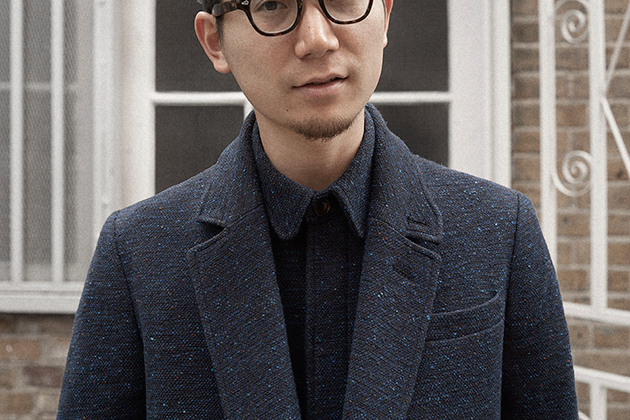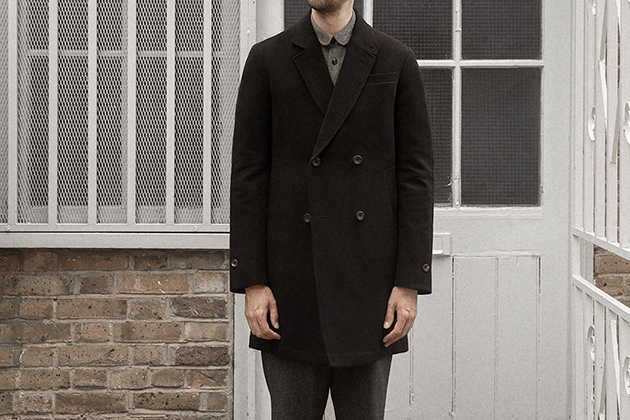Topcoat in heavy moleskin in clay
Prices exclude VAT, shipping is free, and orders leave the workshop within three working days.
Shop
£300.00 — ex VAT
Topcoat, made in London, with a heavy clay-colour cotton moleskin from Lancashire, a lining of wool from West Yorkshire, and dark matte horn buttons from the West Midlands.
Sizing
The coat fits true to size, and so the mannequin — the most standard 38 in the world — wears S. The body is fairly straight, with the waist pulled in slightly. The shoulders are soft and unstructured; the sleeves are an average width.
| XS | S | M | L | XL | |
|---|---|---|---|---|---|
| To fit chest | 36 | 38 | 40 | 42 | 44 |
| Pit-to-pit | 20 | 21 | 22 | 23 | 24 |
| Shoulder | 17½ | 18 | 18½ | 19 | 19½ |
| Sleeve from side-neck | 30½ | 31 | 31½ | 32 | 32½ |
| Back length | 35 | 35½ | 36 | 36½ | 37 |

The topcoat is a fairly long, double-breasted overcoat. When worn, it feels very much like a tailored jacket — only looser, longer, and less structured. This one is made from a heavy moleskin: a soft and warm brushed cotton. It has a collar-latch on one side, which fastens across the neck with a small hidden button.
One of the most novel aspects of the topcoat can be found in its construction: an unusual hybrid of two different types of sleeve. It has a raglan sleeve at the back, see, which provides much more space and freedom of movement than a coat of this ilk would ordinarily be expected to provide.
The front of the coat, though, has an inset constructions (as seen here, or at the top of the page) — which means it retains the nice, crisp semi-formal lines of a classic overcoat. It means the best of most outerwear worlds — and with an extra benefit of a clean tramline running down the top-sleeve.
The coat has four buttons across its front, matte in finish and dark in colour. Each is a little different to the next: a consequence of being an individually made natural product, rather than an ersatz plastic copy. The buttons at the front each have a "backing button" (below-left) to give extra strength.
There are welt pockets on either side at the front of the coat. Just the right height and depth, these pockets, for plunging one's hands inside.
There's an in-breast pocket on the left-side of the coat as worn, with a flap. There's also a chest pocket on the outside (as can be seen in the image at the top of the page).
The coat is half-lined in the body with a flecked merino-wool twill from West Yorkshire — featuring a crisp a little pleat down its centre — while the sleeves are lined with a lightweight cotton.
As worn
The gent here is 5'9", and he is wearing an S. He has a chest size of 38", and there are reports — neither confirmed nor denied — that he weighs in a touch over 11 stone.
Makers of
The coat is made in north-east London. It is a very specialised skill, assembling coats from heavy cloth, and every reasonable step — and the odd unreasonable step — is taken to ensure things are built to last, from the cutting of the pattern to the work on the machine, but without the results being stiff or bulky.
The cloth is sourced from a mill in Lancashire, in north-west England. Cottons have rolled off its line for nearly a century and a half. Industry-leading methods of weaving, dyeing, and finishing — unimproved in decades — along with steadfast adherence to quality, result in some truly first-rate cloth.
The wool lining hails from a mill founded in the Heavy Woollen District of West Yorkshire in the 1800s. Carding, blending, spinning, and weaving — it all happens on the same premises. This unique arrangement means that the fleece’s change into top-grade cloth could not be more tightly tuned.
The horn buttons were cut, shaped, and polished by the last such factory in Britain (now defunct). It was part of a tradition in the Midlands first linked to the meat industry of the 18th century. "It is no easy task," said William Hutton in 1780, "to enumerate the infinite diversity of buttons made in Birmingham."






















